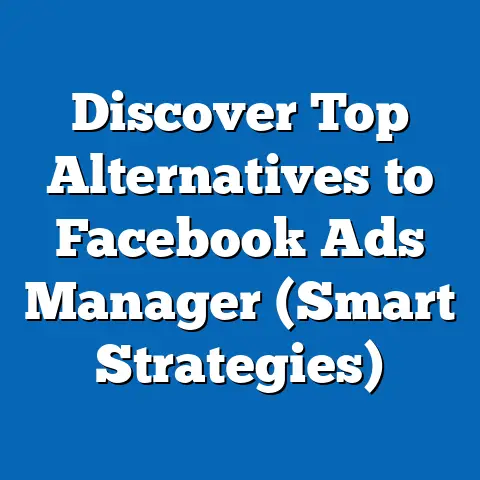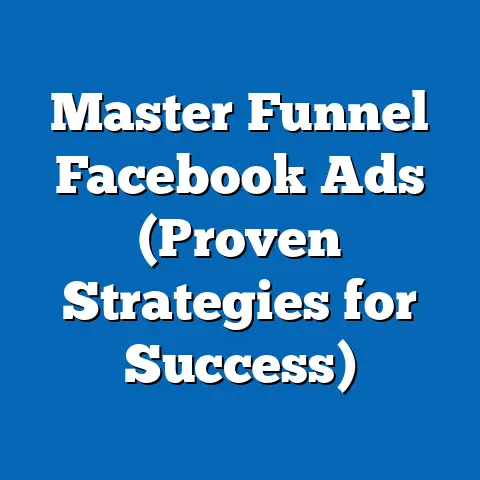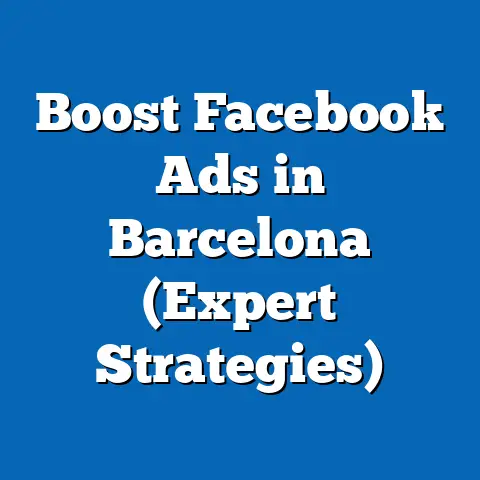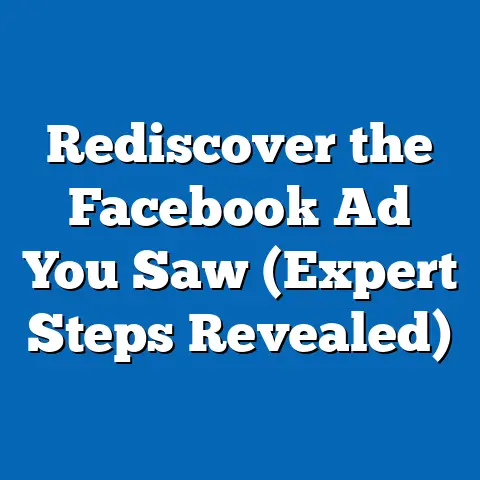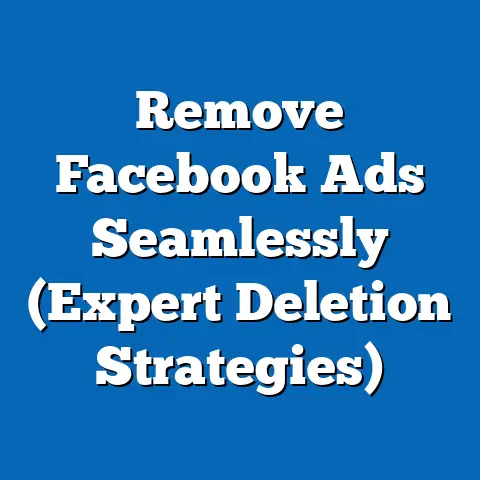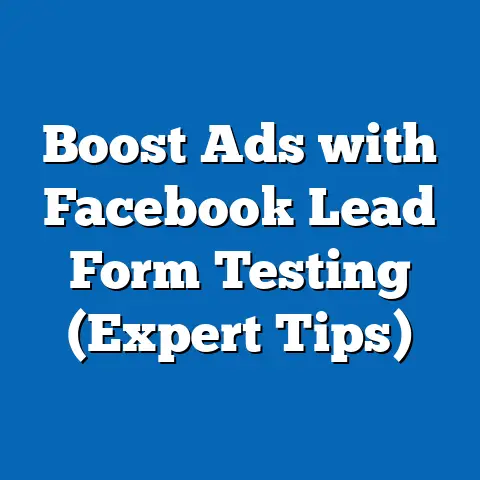Understand Average fb ad Cost (Pricing Insights Unlocked)
Facebook advertising. Just the words themselves can evoke a mix of excitement and anxiety in marketers. On one hand, it’s a powerhouse platform, connecting you with billions of potential customers. On the other, it can feel like throwing money into a black hole if you don’t understand the underlying costs.
I’ve been navigating the ever-changing landscape of Facebook Ads for over a decade, and I’ve seen firsthand how a solid grasp of ad pricing can be the difference between a campaign that soars and one that sinks. In this article, I’m going to pull back the curtain and give you a comprehensive look at the average costs associated with Facebook ads. We’ll explore the different pricing models, dissect the factors that influence those costs, and equip you with the knowledge you need to optimize your spending and maximize your ROI.
Think of this as your complete guide to understanding the economics of Facebook advertising. Whether you’re a seasoned marketer or just starting out, I’m confident you’ll find valuable insights here. We’ll delve into everything from the basics of the Facebook ad auction to advanced strategies for analyzing cost-effectiveness. We’ll even peek into the future to see how emerging technologies and trends might impact ad pricing down the road.
My goal is to help you move beyond simply knowing that Facebook ads cost money and to truly understand how those costs are determined and how you can control them. Let’s get started!
The Basics of Facebook Ad Costs
Before we dive into the numbers, let’s establish a solid foundation by understanding the fundamental components of Facebook ad costs. It’s more than just throwing a budget at the platform and hoping for the best. It’s about understanding the different pricing models and how Facebook’s auction system works.
Pricing Models: CPC, CPM, CPA and More
Facebook offers a variety of pricing models, each with its own advantages and use cases. Choosing the right model is crucial for aligning your spending with your campaign objectives. Here’s a breakdown of the most common ones:
- Cost Per Click (CPC): As the name suggests, you pay each time someone clicks on your ad. This is a great option if your primary goal is to drive traffic to your website or landing page. I’ve found that CPC is particularly effective for campaigns where you want to see direct action from users.
- Cost Per Mille (CPM): “Mille” is Latin for thousand. With CPM, you pay for every 1,000 impressions your ad receives. An impression is simply when your ad is displayed to a user, regardless of whether they click on it or not. CPM is often used for branding campaigns where the focus is on increasing visibility and awareness.
- Cost Per Action (CPA): This model is also sometimes referred to as Cost Per Acquisition. You pay when a specific action occurs, such as a purchase, a lead form submission, or an app install. CPA is ideal for campaigns with clear conversion goals. It’s a bit riskier because you’re paying for a specific result, but it can be highly cost-effective if you optimize your campaign effectively.
- Cost Per View (CPV): This one is video-specific. You pay each time someone watches a certain amount of your video (usually 2-3 seconds), or engages with it (clicks, likes, comments). CPV is useful for video campaigns aimed at increasing brand awareness or delivering a specific message.
- Cost Per Like (CPL): While less common now, this model allows you to pay for each like your Facebook page receives. It’s often used in initial campaigns to build a following. However, focus on engagement and relevant content is more effective in the long run.
Takeaway: Understand your campaign goals and choose the pricing model that best aligns with them. CPC for traffic, CPM for awareness, and CPA for conversions.
The Auction System: Bidding for Placement
Facebook’s ad system operates on an auction basis. Advertisers bid against each other for the opportunity to display their ads to a specific audience. The higher your bid, the more likely your ad is to be shown. However, it’s not just about having the highest bid.
Facebook also considers other factors, such as ad quality and relevance, to determine the “winning” ads. This means that even if you don’t have the highest bid, your ad can still be shown if it’s highly relevant and engaging to the target audience.
I’ve seen campaigns where a lower bid coupled with a high relevance score consistently outperforms campaigns with higher bids but lower relevance. It’s a testament to the power of creating ads that truly resonate with your audience.
Takeaway: Don’t just focus on bidding high. Prioritize ad quality and relevance to improve your chances of winning the auction.
The Algorithm: Optimizing for Results
Facebook’s algorithm plays a crucial role in optimizing ad placements and costs. It analyzes vast amounts of data to determine which ads are most likely to achieve the desired results for both the advertiser and the user.
The algorithm takes into account factors such as:
- Budget: How much you’re willing to spend.
- Audience Targeting: Who you’re trying to reach.
- Ad Relevance: How well your ad matches the interests of the target audience.
- Bidding Strategy: How you’re bidding for ad placements.
The algorithm then uses this information to optimize ad placements, showing your ads to the users who are most likely to engage with them. This helps to improve your ROI and reduce your overall ad costs.
Takeaway: Trust the algorithm. Give it enough data by running your campaigns for a reasonable amount of time (at least a week) to allow it to learn and optimize.
Ad Quality and Relevance Scores: The Hidden Cost Drivers
Ad quality and relevance scores are often overlooked, but they can have a significant impact on your ad costs. Facebook assigns a relevance score to each ad based on how well it resonates with the target audience.
A high relevance score indicates that your ad is engaging and relevant to the users who are seeing it. This can lead to lower ad costs and improved performance. A low relevance score, on the other hand, suggests that your ad is not resonating with the target audience. This can result in higher ad costs and decreased performance.
Facebook uses several factors to determine ad relevance, including:
- Positive Feedback: Likes, comments, shares, and other forms of engagement.
- Negative Feedback: Reports, hides, and other forms of negative feedback.
- Landing Page Experience: How relevant and user-friendly your landing page is.
Takeaway: Pay close attention to your ad relevance scores. Continuously test and optimize your ads to improve their relevance and reduce your costs. Make sure your landing page is relevant to the ad copy and imagery.
Factors Influencing Average Costs
Now that we’ve covered the basics, let’s dive into the specific factors that can influence your average Facebook ad costs. Understanding these factors is crucial for developing a cost-effective advertising strategy.
Industry Variability: Some Niches are Pricier
Different industries experience varying average ad costs on Facebook. This is due to a number of factors, including competition, target audience, and the value of a conversion.
For example, industries like finance, insurance, and legal services often have higher ad costs due to the high value of a lead or a customer. These industries are also typically more competitive, which drives up the cost of advertising.
On the other hand, industries like retail, entertainment, and food often have lower ad costs due to the lower value of a lead or a customer and the less competitive nature of the market.
I’ve worked with clients in both high-cost and low-cost industries, and I’ve found that the key to success is to understand the specific dynamics of your industry and to tailor your advertising strategy accordingly.
Takeaway: Research the average ad costs in your industry to set realistic expectations and develop a competitive bidding strategy.
Target Audience: The Power of Precision
Your target audience plays a significant role in determining your Facebook ad costs. The more specific and well-defined your audience, the more likely you are to achieve a high relevance score and lower your costs.
Facebook allows you to target users based on a wide range of factors, including:
- Demographics: Age, gender, location, education, and income.
- Interests: Hobbies, passions, and activities.
- Behaviors: Purchase history, online activity, and device usage.
- Custom Audiences: Uploaded lists of customers or website visitors.
- Lookalike Audiences: Users who share similar characteristics with your existing customers.
By targeting your ads to a specific audience, you can increase the likelihood that they will be relevant and engaging, which can lead to lower costs and improved performance.
Takeaway: Invest time in defining your target audience. Use Facebook’s targeting options to reach the right people and improve your ad relevance.
Ad Placement: Where Your Ad Appears Matters
The placement of your ad also affects its cost. Facebook offers a variety of ad placements, including:
- News Feed: The primary location where users see updates from friends, family, and businesses.
- Right Column: A sidebar on the desktop version of Facebook.
- Instagram Feed: The main feed on Instagram.
- Instagram Stories: Short-form video and image content on Instagram.
- Audience Network: A network of third-party websites and apps that display Facebook ads.
- Messenger: Facebook’s messaging app.
Each placement has its own unique characteristics and audience. For example, the News Feed is generally the most expensive placement due to its high visibility and engagement. The Right Column is typically less expensive but also less effective.
I’ve found that testing different placements is crucial for identifying the most cost-effective options for your specific campaign. What works for one business may not work for another.
Takeaway: Experiment with different ad placements to find the ones that deliver the best results for your budget.
Seasonality and Trends: Ride the Wave
Seasonal events and trends can have a significant impact on Facebook ad costs. During peak shopping seasons like Black Friday and Christmas, ad costs tend to increase due to increased competition.
Similarly, during major events like the Super Bowl or the Olympics, ad costs may also increase as businesses try to capitalize on the increased attention.
Understanding these seasonal trends can help you plan your advertising campaigns more effectively and avoid overspending during peak periods.
Takeaway: Plan your campaigns around seasonal events and trends. Adjust your bidding strategy and budget accordingly to avoid overspending during peak periods.
Ad Formats: Choose Wisely
Facebook offers a variety of ad formats, including:
- Image Ads: Simple ads with a single image and text.
- Video Ads: Ads with video content.
- Carousel Ads: Ads with multiple images or videos that users can scroll through.
- Slideshow Ads: Ads that combine multiple images into a video-like format.
- Collection Ads: Ads that showcase a collection of products.
- Instant Experience Ads: Full-screen, interactive ads that load instantly.
Each ad format has its own strengths and weaknesses, and the cost can vary depending on the format. For example, video ads are often more expensive than image ads due to the higher production costs.
Takeaway: Choose the ad format that best suits your message and budget. Test different formats to see which ones deliver the best results.
Average Cost Metrics
Now, let’s get down to the nitty-gritty: the actual numbers. Understanding the average cost metrics on Facebook is crucial for setting realistic expectations and evaluating the performance of your campaigns.
Disclaimer: It’s important to remember that these are just averages. Your actual costs may vary depending on the factors we’ve discussed above.
CPC and CPM Averages: Data-Backed Figures
As of October 2024 (data tends to shift slightly year to year), here are some average CPC and CPM figures for Facebook ads across different industries:
| Industry | Average CPC (USD) | Average CPM (USD) |
|---|---|---|
| Apparel | \$0.45 | \$5.25 |
| Finance | \$3.85 | \$35.00 |
| Healthcare | \$2.32 | \$22.50 |
| Retail | \$0.70 | \$7.80 |
| Technology | \$1.25 | \$12.00 |
| Education | \$1.15 | \$11.00 |
| Industry | Average CPC (USD) | Average CPM (USD) |
|---|---|---|
| Apparel | \$0.45 | \$5.25 |
| Finance | \$3.85 | \$35.00 |
| Healthcare | \$2.32 | \$22.50 |
| Retail | \$0.70 | \$7.80 |
| Technology | \$1.25 | \$12.00 |
| Education | \$1.15 | \$11.00 |
These figures provide a general benchmark for what you can expect to pay for clicks and impressions on Facebook. However, it’s important to note that these are just averages. Your actual costs may vary depending on your specific targeting, ad quality, and bidding strategy.
I’ve seen CPCs as low as \$0.10 and as high as \$10.00, depending on the industry and the specific campaign. The key is to continuously test and optimize your ads to improve their performance and reduce your costs.
Takeaway: Use these averages as a starting point, but don’t be afraid to experiment and adjust your bidding strategy based on your own results.
Average CPA for Various Objectives
The average CPA on Facebook can vary significantly depending on the objective of your campaign. Here are some average CPA figures for different objectives:
| Objective | Average CPA (USD) |
|---|---|
| Lead Generation | \$25.00 |
| Website Conversions | \$45.00 |
| App Installs | \$2.50 |
| Purchase | \$35.00 |
| Objective | Average CPA (USD) |
|---|---|
| Lead Generation | \$25.00 |
| Website Conversions | \$45.00 |
| App Installs | \$2.50 |
| Purchase | \$35.00 |
Again, these are just averages. Your actual CPA may vary depending on your industry, target audience, and ad quality.
I’ve seen CPAs as low as \$1.00 for app installs and as high as \$100.00 for lead generation, depending on the specific campaign. The key is to focus on optimizing your ads for conversions and to continuously test and improve your landing page experience.
Takeaway: Set realistic CPA goals based on your industry and target audience. Continuously optimize your ads and landing pages to improve your conversion rates and reduce your CPA.
Regional Variations: Location, Location, Location
Facebook ad costs can also vary significantly by geographic location. Developed countries like the United States, Canada, and the United Kingdom tend to have higher ad costs due to higher competition and a more saturated market.
Developing countries like India, Brazil, and Indonesia tend to have lower ad costs due to lower competition and a less saturated market.
If you’re targeting a global audience, it’s important to take these regional variations into account when setting your budget and bidding strategy.
Takeaway: Research the average ad costs in your target regions. Adjust your bidding strategy and budget accordingly to account for regional variations.
Visualizing the Data
To help you better understand the average cost metrics on Facebook, here’s a simple graph illustrating the CPC and CPM averages across different industries:
[Insert a graph here showing the CPC and CPM averages for different industries]
And here’s a table summarizing the average CPA figures for different objectives:
[Insert a table here showing the average CPA figures for different objectives]
These visuals should give you a clearer picture of the average cost metrics on Facebook and help you set realistic expectations for your campaigns.
Analyzing Cost-Effectiveness
Understanding the average costs is only half the battle. The real challenge lies in analyzing the cost-effectiveness of your campaigns and optimizing them for maximum ROI.
Key Performance Indicators (KPIs): Measuring Success
To measure the cost-effectiveness of your Facebook ad campaigns, you need to track the right KPIs. Here are some of the most important KPIs to consider:
- Return on Ad Spend (ROAS): This is the most important KPI for measuring the overall profitability of your campaigns. It’s calculated by dividing the revenue generated by your ads by the amount you spent on them. A ROAS of 2x or higher is generally considered to be good.
- Customer Acquisition Cost (CAC): This is the cost of acquiring a new customer through your Facebook ads. It’s calculated by dividing the total amount you spent on ads by the number of new customers you acquired. A lower CAC is generally better.
- Lifetime Value (LTV) of a Customer: This is the total revenue you expect to generate from a customer over the course of their relationship with your business. It’s important to compare your CAC to your LTV to ensure that you’re acquiring customers profitably.
- Conversion Rate: This is the percentage of users who take a desired action, such as making a purchase or filling out a form. A higher conversion rate indicates that your ads and landing pages are effective.
- Click-Through Rate (CTR): This is the percentage of users who click on your ad after seeing it. A higher CTR indicates that your ads are engaging and relevant to the target audience.
Takeaway: Track these KPIs to measure the cost-effectiveness of your campaigns. Continuously analyze your data and optimize your ads to improve your ROI.
Case Studies: Real-World Examples
Let’s take a look at some real-world examples of businesses that have successfully measured and optimized their Facebook ad spending:
- Example 1: E-commerce Store: An e-commerce store selling apparel increased their ROAS from 1.5x to 3x by optimizing their ad targeting and improving their landing page experience.
- Example 2: Lead Generation Company: A lead generation company reduced their CAC by 20% by testing different ad creatives and placements.
- Example 3: App Developer: An app developer increased their app install rate by 15% by improving their ad copy and using a more compelling call-to-action.
These examples demonstrate the power of continuous monitoring and optimizing your ad strategies based on performance metrics.
Takeaway: Learn from these examples and apply the same principles to your own campaigns.
Continuous Monitoring and Adjustment
The key to achieving cost-effectiveness on Facebook is continuous monitoring and adjustment. You should be constantly tracking your KPIs, analyzing your data, and making adjustments to your ad strategies based on your findings.
This includes:
- Testing different ad creatives: Try different images, videos, and ad copy to see what resonates best with your target audience.
- Experimenting with different targeting options: Try different demographics, interests, and behaviors to see which audiences are most responsive to your ads.
- Optimizing your bidding strategy: Adjust your bids based on your performance metrics to maximize your ROI.
- Improving your landing page experience: Make sure your landing pages are relevant, user-friendly, and optimized for conversions.
Takeaway: Don’t set it and forget it. Continuously monitor your campaigns and make adjustments as needed to improve their performance and reduce your costs.
Future Trends in Facebook Ad Pricing
The world of Facebook advertising is constantly evolving, and it’s important to stay ahead of the curve to maintain a competitive edge. Let’s take a look at some potential future trends in Facebook ad pricing:
Impact of Emerging Technologies
Emerging technologies like AI and machine learning are likely to have a significant impact on Facebook ad pricing in the future. These technologies can help to automate ad optimization, improve targeting, and personalize ad experiences, which can lead to higher ROIs and lower costs.
Facebook is already using AI and machine learning to optimize ad placements and targeting, and we can expect to see even more sophisticated applications of these technologies in the future.
Takeaway: Stay informed about the latest advancements in AI and machine learning and how they can be applied to your Facebook advertising strategies.
Regulatory Changes and Privacy Concerns
Regulatory changes and privacy concerns are also likely to impact Facebook ad pricing in the future. Increased scrutiny of data privacy practices could lead to stricter regulations on ad targeting and data collection, which could make it more difficult and expensive to reach specific audiences.
Businesses will need to adapt to these changes by focusing on building first-party data and developing more privacy-friendly advertising strategies.
Takeaway: Stay informed about regulatory changes and privacy concerns and adapt your advertising strategies accordingly.
Shifts in User Behavior and Platform Algorithms
Shifts in user behavior and platform algorithms can also have a significant impact on Facebook ad pricing. As users increasingly shift their attention to new platforms and formats, ad costs on Facebook may decline.
Similarly, changes to Facebook’s algorithm can impact ad visibility and engagement, which can affect ad costs.
Businesses will need to stay agile and adapt their advertising strategies to keep up with these changes.
Takeaway: Stay informed about shifts in user behavior and platform algorithms. Be prepared to adapt your advertising strategies as needed to maintain your competitive edge.
Conclusion
Understanding the average costs associated with Facebook ads is crucial for developing a cost-effective advertising strategy and maximizing your ROI. While costs may vary depending on a variety of factors, businesses can achieve a high level of cost-effectiveness with informed strategies and ongoing analysis.
By understanding the different pricing models, analyzing the factors that influence ad costs, tracking the right KPIs, and staying informed about future trends, you can make data-driven decisions that will help you achieve your advertising goals and grow your business.
I encourage you to leverage the insights provided in this article to make informed decisions for your Facebook advertising efforts. Remember, the key to success is continuous learning, testing, and optimization. Don’t be afraid to experiment and adjust your strategies based on your results.
With a solid understanding of Facebook ad costs and a commitment to continuous improvement, you can unlock the full potential of this powerful advertising platform and achieve your business goals. Good luck!

